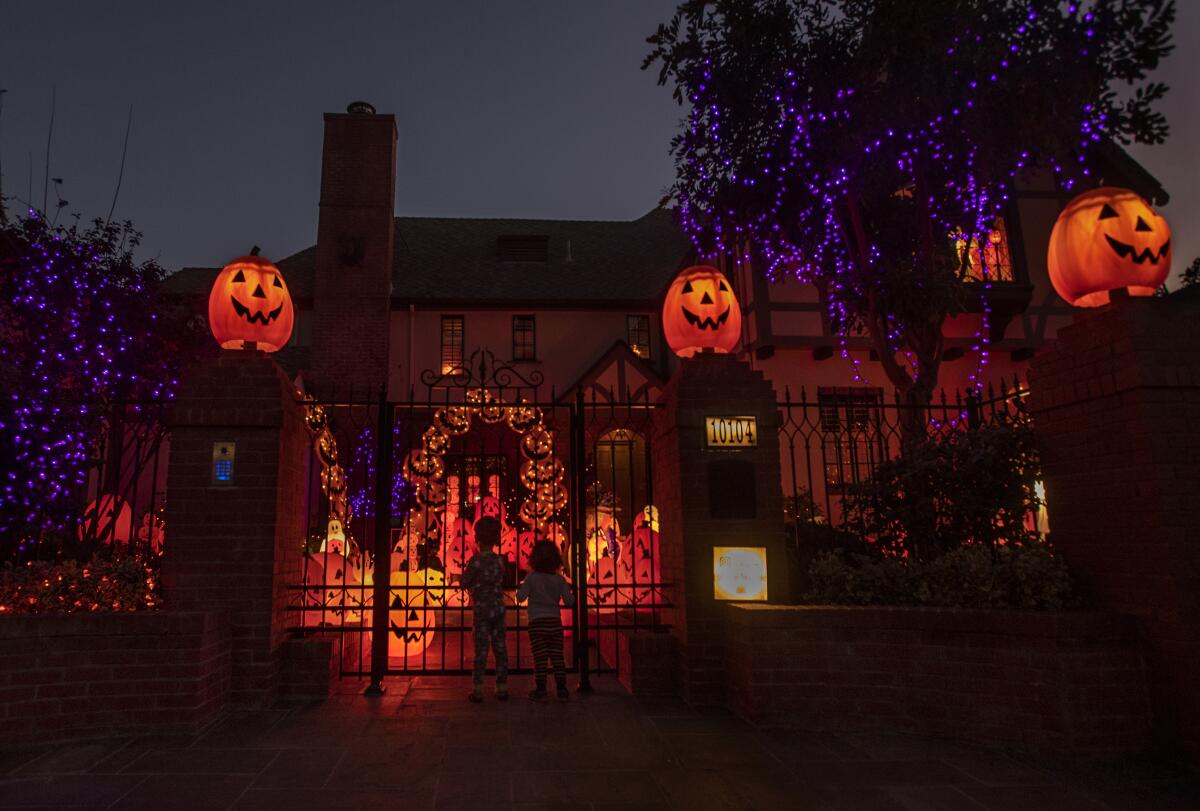Editorial: Halloween’s scariest threats? Not razor blades or ‘rainbow’ fentanyl, but rumors and lies

- Share via
Like roller coasters and horror movies, Halloween amps up the fun by mixing in a dose of fear. Go too light on the scariness — make the coaster too slow, for example, or the monster too tame — and the enjoyment drains away.
Perhaps that’s why we keep injecting fake but real-sounding fear into Halloween. Wicked witches don’t scare us much these days, so we convince one another that trick-or-treaters could be snatched off the porch by child molesters, or that their insides might be carved up by pins or razor blades hidden in candy.
Or — in this year’s twist — they might be poisoned by “rainbow fentanyl,” disguised as Skittles or other candy.
First off, there is no evidence — as in zero, none — that drug kingpins are planning to drop candy boxes filled with synthetic opioid poisons disguised as multicolored Halloween candies into trick-or-treat bags on Monday night. Nor have there ever been, through the decades, any verified reports of sharp objects hidden in candy, or molesters grabbing the neighbor kids at their front doors on Halloween night.
So where do these stories come from? And why are they so powerful?
Take fear over people’s differences, mix in deep anxiety over a perceived danger and you’re on the way to turning an urban legend into mass hysteria.
The rainbow-fentanyl-as-Halloween-candy tale appears to have begun with an August news release from the U.S. Drug Enforcement Administration. “Rainbow fentanyl — fentanyl pills and powder that come in a variety of bright colors, shapes, and sizes — is a deliberate effort by drug traffickers to drive addiction amongst kids and young adults,” DEA Administrator Anne Milgram said.
Then in September, Republican National Committee Chairwoman Ronna McDaniel linked reports of fentanyl entering the U.S. from Mexico with Halloween approaching.
“Every mom in the country right now is worried, what if this gets into my kid’s Halloween basket, the rainbow fentanyl?” she said. “What if my teenager gets this? And the Democrat Party is ignoring this.”
But the Democrats weren’t ignoring it. “Halloween is coming up,” Senate Majority Leader Charles E. Schumer (D-N.Y.) said after showing pictures of candy and rainbow fentanyl that looked remarkably similar. “This is really worrisome and really dangerous.”
News outlets have taken these cues and run with them, warning parents to be on the lookout for fentanyl in their kids’ Halloween candy.
Meanwhile, Halloween poisoning nonsense aside, the U.S. does indeed face an all too real and dangerous fentanyl problem, which gives the fake stories the illusion of credibility. Fentanyl is a lethal opioid. It has reportedly poisoned at least seven teenagers in Los Angeles in recent weeks. In September, 15-year-old Melanie Ramos died after ingesting a fentanyl tablet she reportedly believed to be a less powerful painkiller given to her by another student.
Warnings and interventions are appropriate. It is wise of the L.A. Unified School District and county libraries to stock naloxone to prevent overdose deaths.
But there is no evidence that the students who ingested fentanyl thought they were eating candy. They apparently knew they were taking drugs.
Public officials should know better than to perpetuate myths used to misdirect resources and cede more power to police.
The rainbow fentanyl scare checks all the boxes of modern-day urban legends: legitimate parental concern about safety, actual dangers such as taking unpackaged drugs from a questionable source, counterfactual assertions by people in authority, and less-than-precise news reporting and commentary colored by speculation and fear.
And, as McDaniel and Schumer demonstrate, there’s one more important factor this year: election year politics. It’s an accident of the calendar that Halloween usually falls a week before election day, give or take a few days. That gives partisans an added incentive to gin up stories about evil substances being ferried illegally across the border, and about how the wicked incumbents or foul challengers are failing to stop the flow.
It doesn’t help that police recently intercepted fentanyl tablets hidden in candy boxes in order to evade detection.
Experts say the fancy colors are used to fool inspectors, not to entice kids, and that makes sense. Drug dealers want their costly and illicit products to enter the country and be repackaged for distribution. They want to addict a clientele with access to money. They have little reason to target an elementary school child’s milk money. They have no more reason to give away their poisons to trick-or-treaters of 2022 than the imagined witches and goblins of years past had to stick needles into candy bars. They didn’t lace Halloween candy with heroin in the 1970s, cocaine in the 1980s or meth in the 2000s.
And there is no evidence that any Halloween candy has been or will be replaced by, or contaminated with, fentanyl. It’s this year’s urban legend, keeping parents (and voters) on edge. We can hardly wait to see what next year’s Halloween panic will be.
More to Read
A cure for the common opinion
Get thought-provoking perspectives with our weekly newsletter.
You may occasionally receive promotional content from the Los Angeles Times.












